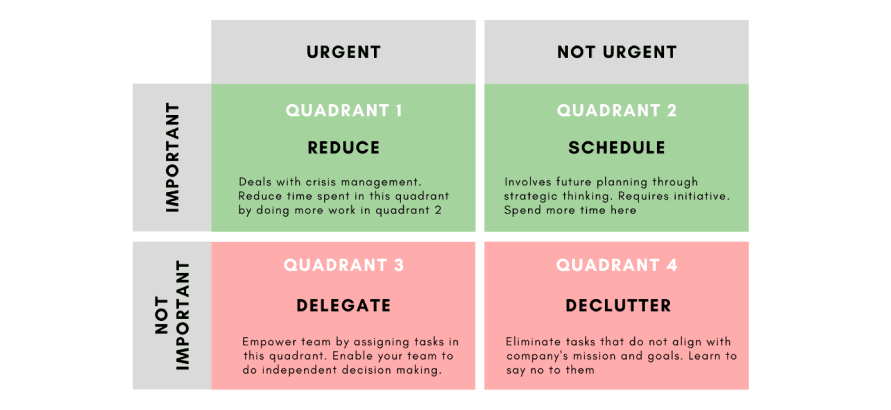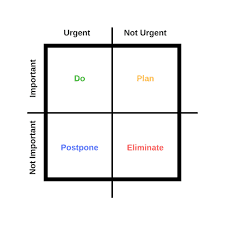Measure a task’s urgency
Break down a master to-do list into four sections:
- Urgent and important: These tasks should be done today.
- Not urgent but important: Schedule these tasks for later.
- Urgent and not important: These tasks should be delegated.
- Not important and not urgent: Delete it from your list.
To move ahead of that to-do list, spend most of your time on tasks that are important but not yet urgent.
1.75K
3.45K reads
CURATED FROM
IDEAS CURATED BY
The idea is part of this collection:
Learn more about timemanagement with this collection
How to manage digital distractions
The impact of technology on mental health
The importance of setting boundaries
Related collections
Similar ideas to Measure a task’s urgency
The Eisenhower Matrix
The Eisenhower Matrix productivity method lets you consider the urgency and importance of each task. This method breaks tasks into four quadrants and prescribes how we should deal with tasks in each block.
- Urgent and Important tasks: should be ...
3. Eisenhower Matrix
An Eisenhower Matrix breaks a to-do list into the four categories below:
- Has items that are both urgent and important, is to be tackled immediately.
- Items that are important but not urgent, can be scheduled for a later time.
- Tasks deemed urgent but...
2. The Eisenhower Matrix / The Eisenhower box
Once you have your goals written in a SMART way, you should break them down into concrete and actionable tasks.
Then the tasks need to be prioritized.
This matrix recommends arranging tasks in one of the four quadrants:
- Urgent + Important (Do first)
- Not Urgent + Im...
Read & Learn
20x Faster
without
deepstash
with
deepstash
with
deepstash
Personalized microlearning
—
100+ Learning Journeys
—
Access to 200,000+ ideas
—
Access to the mobile app
—
Unlimited idea saving
—
—
Unlimited history
—
—
Unlimited listening to ideas
—
—
Downloading & offline access
—
—
Supercharge your mind with one idea per day
Enter your email and spend 1 minute every day to learn something new.
I agree to receive email updates


